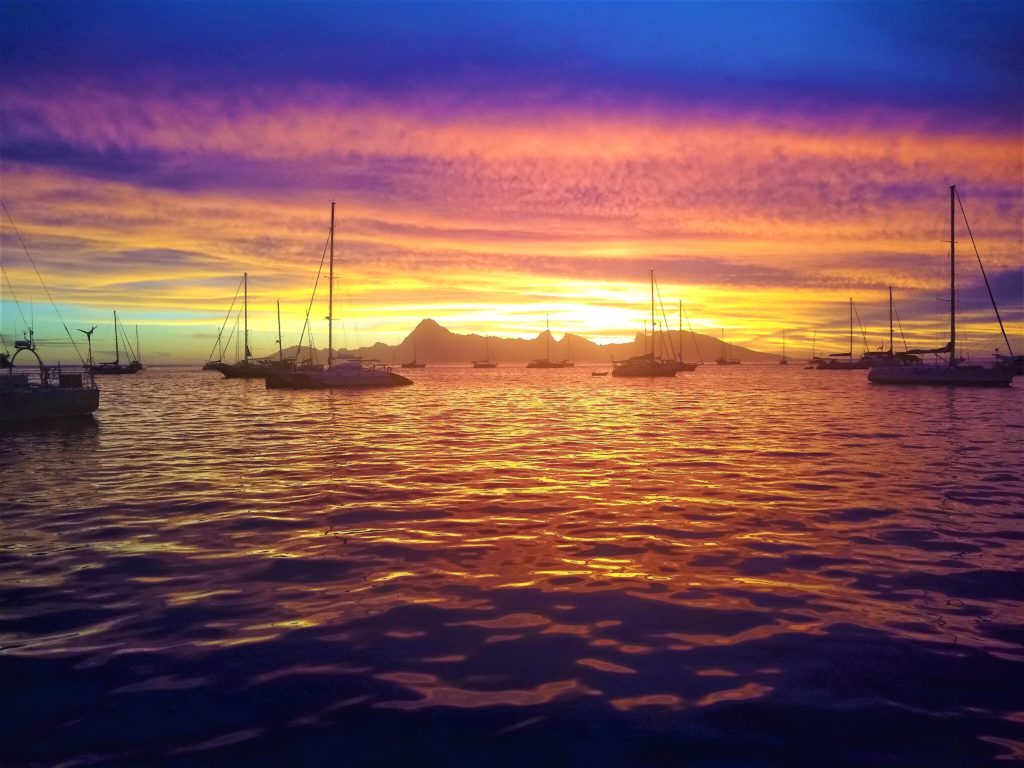
It is only a 200 mile passage from Toau to Tahiti. The predict wind grib files called for light winds on the beam – 5 to 12 knots. The weather appeared calm. This will be an easy if boring passage we thought… Were we ever mistaken!
This 200 mile stretch turned out to be one of our more challenging passages of the trip to date. The weather we experienced did not show up on our grib files. And again we learned how a small mistake can turn into a larger issue which snowballs quickly. On the water, being prepared, no matter what the forecast, was a lesson we learned (again!).
A note on Predict Wind/Grib files
We use Predict Wind – a weather service used by many cruisers. We can access weather files using our Iridium Go Satellite device. We download these ‘grib files’ to our Ipad, and the result is an image very similar to what you see if you use ‘Windy’ – a colour-coded image showing predicted wind direction and speeds in the location requested. We can download 4 different weather models and also request current, wave height and other conditions. We can even do passage routing – with ‘comfort’ modes or ‘fasted route’ modes. All in all it is a good system and it has shown itself to be reliable for the most part. It is invaluable to have on demand weather wherever we are.
However, the key to remember with grib files is that they are not looked at by a professional meteorologists prior to issuing – in this way they are different from a traditional weather forecast which has had a professional review and put their name to the forecast. Also, an perhaps more importantly, they do not show (at least in our experience) localized impacts on wind caused by geography (ie land) nor to they accurately show squalls or the Inter-tropical or Southern Tropical Convergence Zone which are inherently unpredictable.
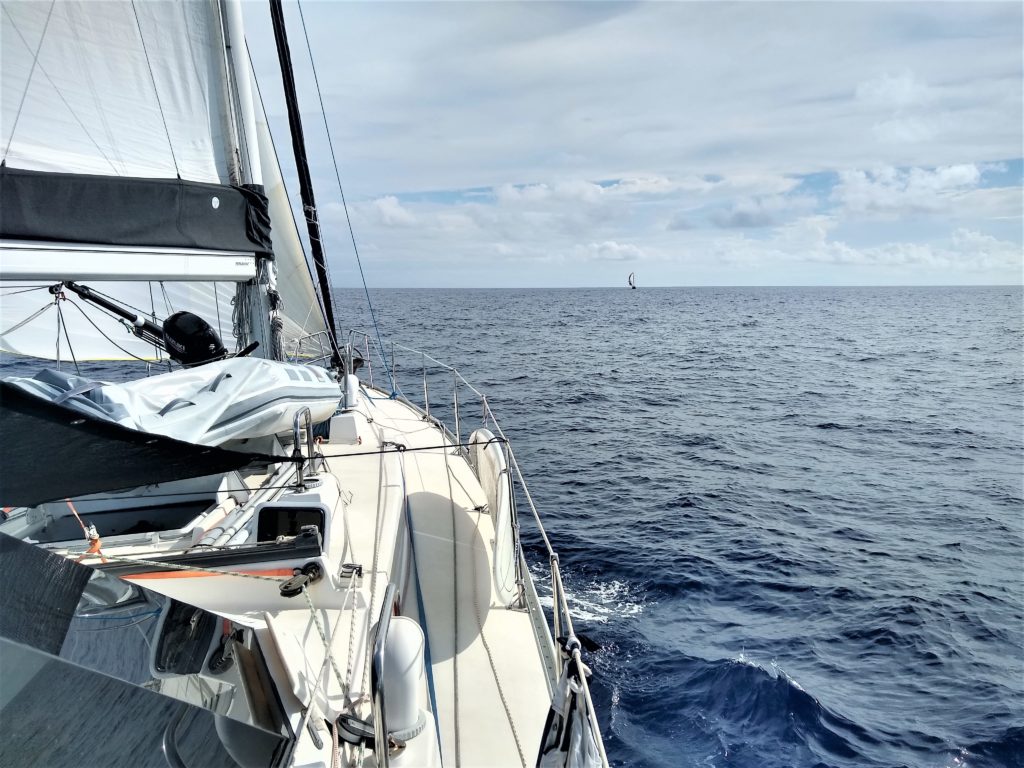
Synoptic Charts: important addition to Grib Files
We also regularly download ‘big picture’ weather charts from NOAA which provide 25 kb (ie small and downloadable using our satellite device) synoptic weather charts showing isobars with fronts, ridges and troughs drawn on (ie prepared by professional weather forecasters). We should have looked at this chart a bit more closely prior to departing!
Also, we had previously read Jim Coreman’s excellent articles on weather in the South Pacific from old issues of Lattitude 38 (and have these stored on our navigation computer, as well as other weather resources). In these articles Jim expertly delineates the nuances of interpreting weather in the southern pacific latitudes including strategies for navigating around (and through) the South Pacific Convergence Zone.
That being said, we set off, along with our friends aboard SV Flocerfida, prepared for a light wind easy passage to Tahiti. Our biggest concern was that we would run out of wind…
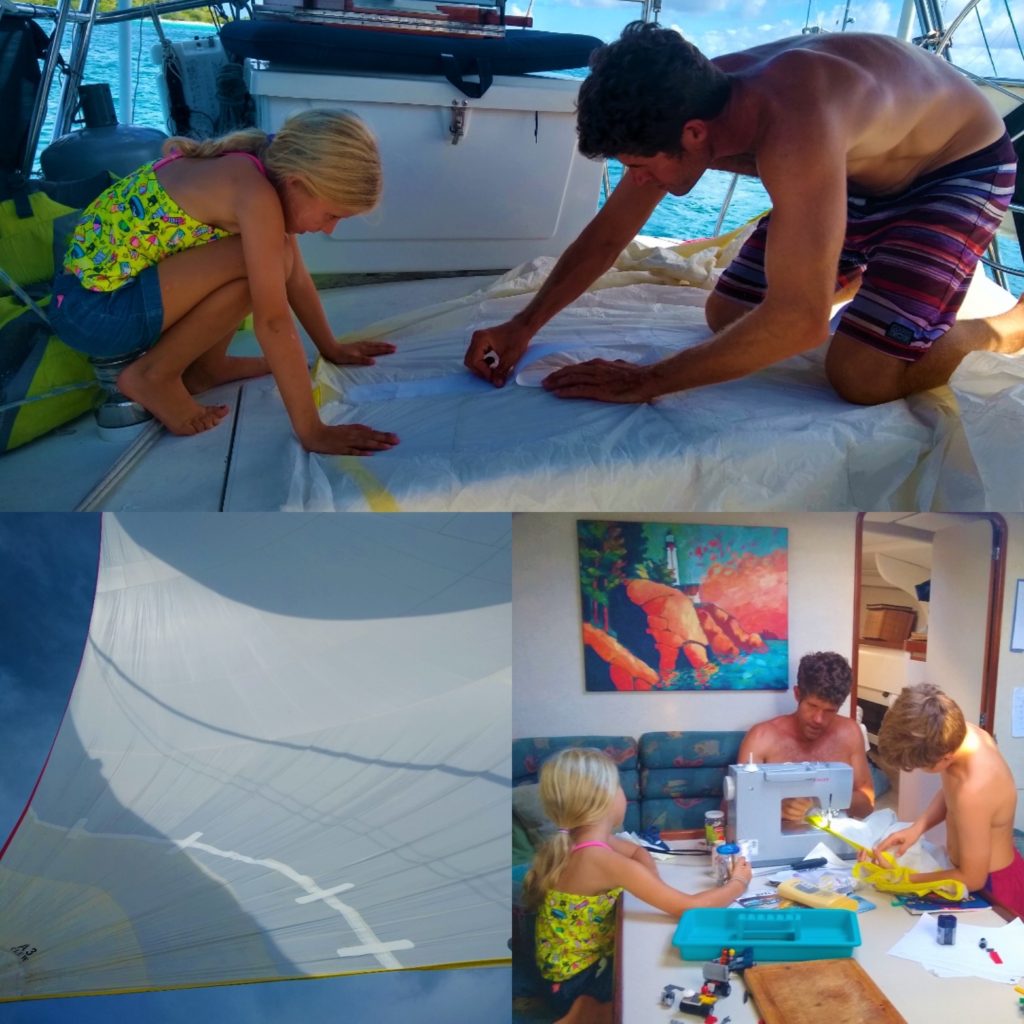
Wow, look at that dark cloud line on the horizon!
We set off with our newly repaired spinnaker flying and wishing for a bit more wind as we headed west. Not long after, we were forced to motor sail as our speed dropped and the wind died. We changed sails and put up our code zero which we have on a furler and continued to motor at a low rpm, searching for wind. Then we furled the zero and continued to motor. There was no wind at all.
The water turned to glass and we were enjoying watching a large pod of dolphins swim and play in our bow wave. I looked to the horizon and wondered aloud about the dark foreboding cloud-line on the horizon.
Just a squall we thought. Nothing to get too worried about. We’d seen dark clouds on the horizon before and been able to navigate through the scattered squalls. We would just monitor our radar and adjust our position as needed.
Gavin went downstairs to finish making yogurt (we love our instant pot and have been making yogurt on a regular basis – kids love it!) as I sat in the cockpit as we slowly made our way motor sailing into the distance.
In an instant, the wind picked up. Suddenly, the water was full of dark squally patches, and I heard a loud flapping noise. We were still a good distance from the dark area up ahead and I thought it was our somewhat large courtesy flag flapping in the breeze. The wind picked up more and then I realized, nope – that was our furled code zero becoming partially unfurled at the top and flapping loudly in the increased wind. We’d run into a wall of opposing wind and the code zero needed to come down now!
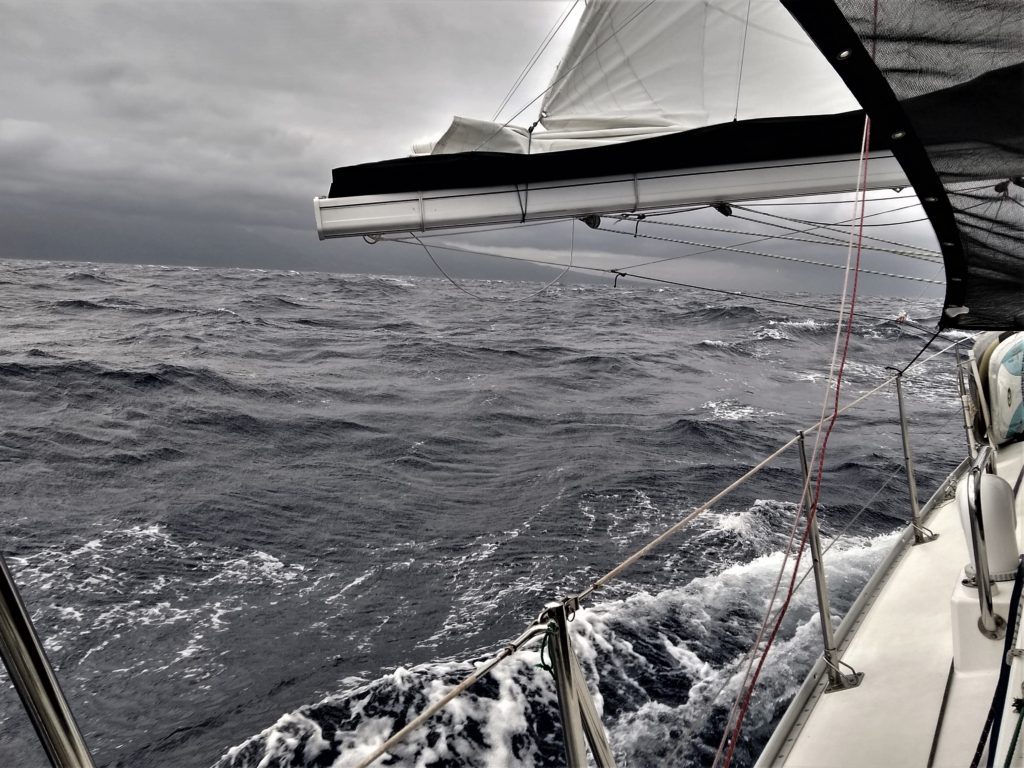
What does that engine alarm mean?
The boat was healing over with the main in and the partially furled code zero flapping crazily and loudly. We bore off to flatten out the boat and to take the pressure off the foresail and eased the main. And just as Gavin was getting ready to go forward to douse the zero onto the deck, we both heard the engine alarm go off. “Oh ” says Gavin. He knew exactly what that sound meant. It took me a couple seconds and then I realized too.
The sheet (rope) for the code zero had caught around the propeller and the engine alarm sound was caused by dropping oil pressure because the engine had come to an abrupt halt!
All that flapping of the zero had dislodged a sheet (usually secured in the cockpit!) to go over the side. The wind had come up so quickly the engine was still running. When we bore off, we drove right over the sheet. Arg! Now we had no engine. At night. In big breeze. With atolls (sharp reefs!) on either side of us. (Yes, they were 4 miles on either side of us, but still!)Wow, another lesson in how fast things can change!
We doused the zero and unfurled our jib. We went from motor sailing in no wind to beating into 25 knots, gusting higher. And now we had no motor. That is one thing when we are in the open ocean, but quite another when we are sailing at night in an atoll strewn area.
We checked our position (thank goodness for chart plotting software) and saw that we would need to beat upwind (zig zag tacking) directly into the wind into this increasing breeze, in order to stay mid channel. On each side of us there were atolls and we wanted to stay far away from them. Every year in the Tuamotus boats get washed ashore on the treacherous reefs and currents surrounding atolls and we did not want this statistic to include us!
Suddenly our expected calm boring passage turned into a beat upwind into 25 knots. As we reassessed our position and checked wind forecasts again by downloading new weather – (showing nothing that we were experiencing) and realizing that this was no squall (radar images did not show typical squalls that we’d been used to). There was no rain, and the wind had completely changed and was continuous in the opposite direction. We’d sailed into a large area of completely opposing wind. We watched as the gusts drew even higher, readings on our anemometer into the mid 30’s.
We re-read Jim Coreman’s explanation of the South Tropical Convergence zone and advice (don’t turn around sailing into the unstable convergence area if you encounter this phenomenon, keep sailing south, upwind, away from the zone.) So we continued beating into the large seas and carefully noting our position on the chart to keep clear from the atolls on either side.
We radio’d to our friends and lamented the change in weather and continued on. They were motoring into the breeze but we had no choice but to sail. We were happy that we had a boat that could sail decently upwind in a situation such as this.
Many hours later, we’d sailed far enough away from the convergence zone (and thankfully now 12 miles away from the nearest atoll) and again the wind had dropped off completely. However a large swell from the south and mixed up swells from the convergence zone we’d sailed through, made for sloppy seas.
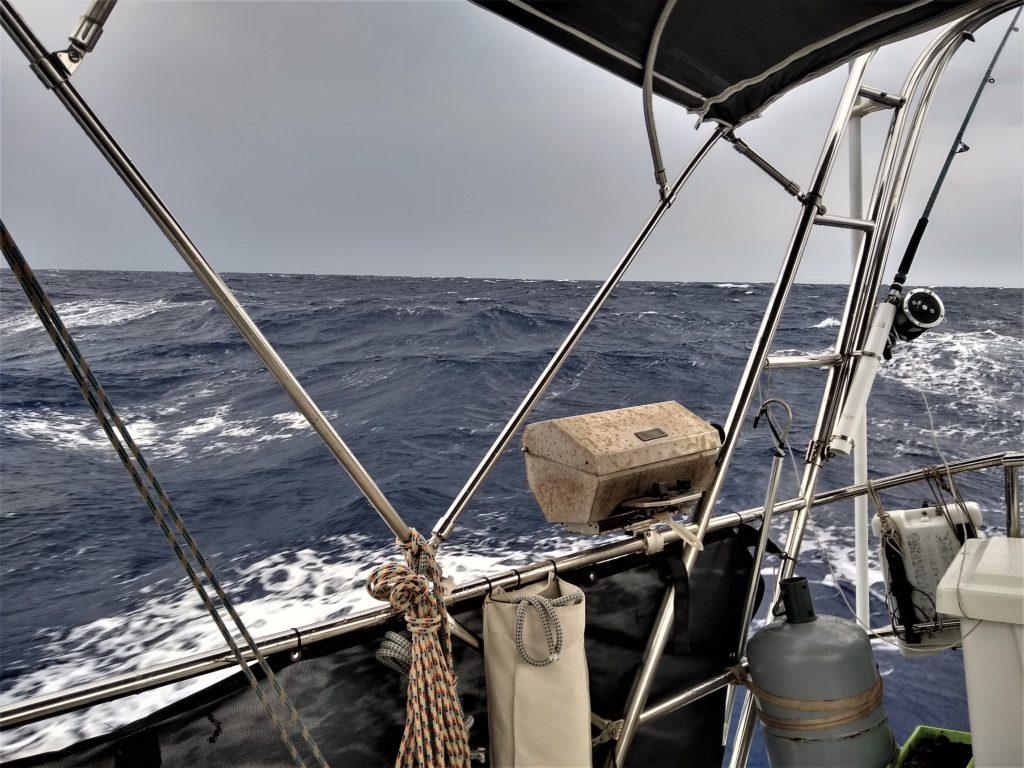
Clearing the Propeller – at night!
The speed gauge said zero/zeros for sometime, and we were flopping around in the dark, when Gavin said, “Jenn, I’ll need your help to hold the light. I’m going in to clear the prop.”
“Um..” I was thinking. “At night? Lets wait until daylight when it will be easier to see.”
“No”, says Gavin, “I’m not sure what the wind will be like at daylight, or the swells. There is no wind now. The sea state isn’t too bad. This is as good a time as any. I’ll just give it a try. If I need to wait to daylight I’ll wait but I’d like to try it at least. Please can you hold the light.”
Unfortunately (or fortunately?) Gavin has had some experience clearing props with sheets we’d run over in the past. On this boat he’d had to do this a couple of times previously (both in daylight – one on crossing from Hawaii to Point Roberts and one near the fuel dock in La Paz when we’d reversed over our dinghy’s towline – oops!). And on one of our previous boats many years ago (Dash 34) we’d run over a line at night with a boat full of friends after watching the fireworks and Gavin bravely jumped over the side with the aid of friends’ phone lights shining through the water where he miraculously was able to untangle the prop.
Gavin is confident in clearing the propeller – usually the line just wraps around the propeller shaft and needs to be unwound – the tricky part is that the line can be jammed and pulled tight which makes it difficult to dislodge. But this time, at night, in the miles deep Pacific(?!) I was not so sure… We tried unwinding the shaft from inside the engine room to see if we could dislodge the line that way. No luck.
Gavin took several dives under the boat in the full moonlight and with me shining our brightest flashlight over the side. He tied himself on with a line attached to the boat, then took a deep breath and dove underneath. With the aid of a knife, and several dives later, soon enough the tangle was dislodged (great job Gavin!) and we again had our motor to get us into the next wind zone – and boy did it ever arrive!
Speedy bumpy finish into Tahiti
Gavin was right to get the prop free when he could as conditions significantly deteriorated when daylight hit. We were still in a very unstable area with the gribs again not showing anything we were experiencing.
At one point we were seeing sustained mid 30 knots (from behind this time), steady downpouring rain and we were doing steady 10 to 12 knots with only a double reefed main. I remember Gavin telling me to bear off and I was clicking the auto pilot to take us down a few degrees. Our auto Pilot has two settings, one to ‘click’ with adjustments (slow) and fast (the ‘dial’). When the clicks weren’t working quickly enough I gazed at the wind gauge and was startled to see the wind up above 30 steady. Wow, the main was loaded up and no wonder it was taking a bit of time to bear off with the slow setting.
“Gavin!” I called, “Do we need another reef?” Sometimes behind the dodger we can get complacent and it was hard to see the sea state with the steady rain.
We were within 12 miles of Tahiti thinking that there was no way we could enter the pass in these conditions. We were looking at options when we heard the Port Captain from Papetee assure us that the pass was fine and there was no concern in transiting in these seas and wind. I was skeptical about this report, in disbelief that the pass could be fine in these conditions and kept researching Plans “B” and “C” in case we determined the pass was not passable.
However, sure enough, 5 miles out from Tahiti, the seas began to get a bit smaller and the wind eased off. We transited the pass without issue and were happy to find a space in the tightly packed anchorage off of Marina Taina.
We were amazed to breathe in the fragrant smell of moist earth and flowers as we motored alongside the airport in the channel leading to the anchorage. One of my favourite things about finishing a passage is the smell of the land. Whether it is the hot dry sweet grass smell of the gulf islands in our home waters or the summer beach smell of drying seaweed, the exotic smells of Tahiti are among the best so far! Welcome to Tahiti!
(Note for any future sailors in this area, there is plenty of room inside the pass (Passe Papeete) to douse the main. We chose to douse outside the pass just to be safe in case there was not sufficient room inside which meant turning into large swells which was doable but not fun.)
So what happened with the weather out there?
We sailed through the South Pacific Convergence Zone. This characteristically unstable weather does not show itself on the grib files. However, had we looked closer at our Synoptic chart we would have seen reference to the Convergence zone in the area we were sailing, enough to think twice about our route and departure date. We also decided that it would be best to set sail in conditions showing steady trade winds in future, meaning that the convergence zone would be further North of us. Next time!
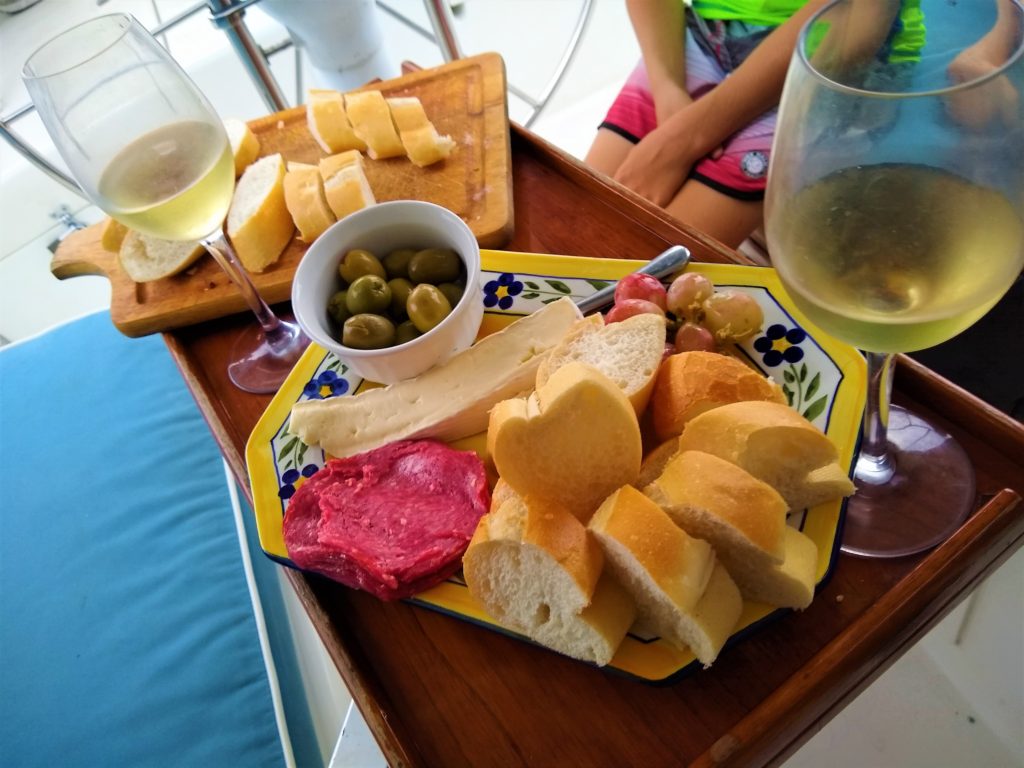

Good to see you are all safe and well after a challenging trip, even if it was not without it’s challenges.
Have fun and say Hi to everyone.
Dad
Great information and advice…. thanks !! and pictures are lovely.
Brian Johnson
Thanks Brian!